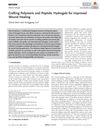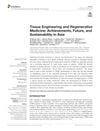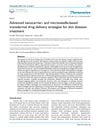TLDR The hydrogel helps heal diabetic wounds quickly and effectively.
The study presents a novel hydrophobic hydrogel, QL@MAB, designed for diabetic wound therapy. This hydrogel is composed of hydrophobic methyl acrylate and (3-acrylamidophenyl)boronic acid, co-loaded with antioxidant quercetin and antibiotic levofloxacin. The hydrogel mimics skin structure, with hydrophobic segments forming a dense "epidermis" for prolonged drug diffusion and water retention, while glucose-labile "sweat pores" facilitate drug release in hyperglycemic conditions. In diabetic rats, QL@MAB promotes rapid wound healing, angiogenesis, hair follicle regeneration, and extracellular matrix remodeling, showcasing its potential as a multifunctional dressing for diabetic wounds.
74 citations
,
October 2023 in “Nature Reviews Molecular Cell Biology”  1 citations
,
August 2023 in “Military Medical Research”
1 citations
,
August 2023 in “Military Medical Research” Smart hydrogel dressings could improve diabetic wound healing by adjusting to wound conditions and controlling drug release.
 421 citations
,
January 2015 in “Chemical Society Reviews”
421 citations
,
January 2015 in “Chemical Society Reviews” Improving artificial vascular grafts requires better materials and surface designs to reduce blood clotting and support blood vessel cell growth.
 68 citations
,
March 2019 in “Advanced Healthcare Materials”
68 citations
,
March 2019 in “Advanced Healthcare Materials” Advanced hydrogel systems with therapeutic agents could greatly improve acute and chronic wound treatment.
 119 citations
,
March 2020 in “Frontiers in Bioengineering and Biotechnology”
119 citations
,
March 2020 in “Frontiers in Bioengineering and Biotechnology” Asia has made significant progress in tissue engineering and regenerative medicine, but wider clinical use requires more development.
 67 citations
,
January 2022 in “Theranostics”
67 citations
,
January 2022 in “Theranostics” Advanced nanocarrier and microneedle drug delivery methods are more effective, safer, and less invasive for treating skin diseases.
 34 citations
,
October 2021 in “Scientific Reports”
34 citations
,
October 2021 in “Scientific Reports” Nobiletin-loaded vesicles effectively treat skin cancer by restoring normal miRNA and antioxidant levels.






